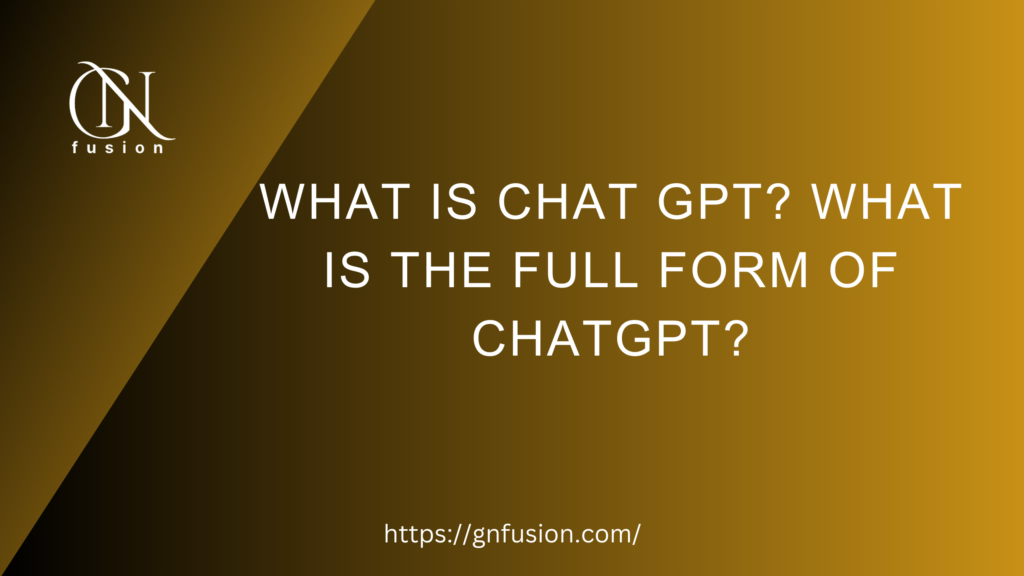Introduction
In recent years, natural language processing (NLP) has made significant strides, thanks to advancements in deep learning and artificial intelligence (AI). Today, we have language models that can generate human-like responses to prompts, perform language translation, and even generate text that is difficult to distinguish from human-written content. One such model is ChatGPT, developed by OpenAI. In this blog post, we’ll explore what ChatGPT is, its full form, and its applications in NLP.
What is ChatGPT?
ChatGPT is a conversational AI model that is specifically designed for text-based interactions. It is based on the Generative Pre-trained Transformer (GPT) architecture, which is a type of deep learning model that has been pre-trained on a large corpus of text. The goal of the GPT architecture is to generate natural language that is contextually relevant and coherent.
The original GPT model was developed by OpenAI in 2018, and it quickly became popular among researchers and developers in the field of NLP. The model was trained on a massive dataset of over 40GB of text, which included everything from news articles and books to social media posts and online conversations. The model was able to generate human-like responses to prompts, and it quickly became popular among researchers and developers in the field of NLP.
Since then, OpenAI has continued to improve upon the original GPT model, and they have released several new versions, each one more advanced than the last. The latest version, GPT-3.5, is the basis for the ChatGPT model.
What is the full form of ChatGPT?
The full form of ChatGPT is “Chat Generative Pre-trained Transformer.” As the name suggests, the model is designed for generating natural language responses in chat-based interactions.
How does ChatGPT work?
ChatGPT works by generating natural language responses to prompts based on the context of the conversation. The model is trained on a large corpus of text, which includes a diverse range of content types such as books, news articles, social media posts, and online conversations.
The training data is used to pre-train the model, which involves training the model to understand the structure and nuances of human language. Once the model is pre-trained, it can be fine-tuned on a specific task, such as chatbot development. The fine-tuning process involves training the model on a smaller dataset that is specific to the task at hand. The goal of the fine-tuning process is to improve the model’s accuracy and performance on the task.
Once the model is trained and fine-tuned, it can be integrated into a chatbot or virtual assistant. The chatbot can interact with users by generating responses to their prompts, which can be in the form of text, voice, or any other modality. The chatbot can also understand and interpret user inputs and respond accordingly.
What are the advantages of using ChatGPT?
ChatGPT offers several advantages over traditional chatbots and virtual assistants. These include:
Natural language processing: ChatGPT is trained on a large corpus of text, which enables it to understand the nuances of human language. This allows the chatbot to generate responses that are contextually relevant and coherent.
Multi-turn conversations: ChatGPT is capable of generating responses to multi-turn conversations. This means that the chatbot can maintain context across multiple prompts and generate responses that are relevant to the conversation.
Human-like responses: ChatGPT can generate responses that are difficult to distinguish from human-written content. This can improve user engagement and satisfaction with the chatbot.
Flexibility: ChatGPT can be trained and fine-tuned on a wide range of tasks, including customer service, sales, and Scalability: ChatGPT can be trained on a large dataset, allowing it to handle a large volume of conversations and interactions simultaneously. This makes it ideal for use in large-scale applications.
Customizability: ChatGPT can be customized to meet the specific needs of an organization or business. This means that the chatbot can be tailored to provide personalized responses and experiences to users.
Cost-effectiveness: ChatGPT can reduce the cost of customer service and support by automating routine tasks and providing 24/7 support to users.
Applications of ChatGPT
ChatGPT has a wide range of applications in various industries and domains. Some of the most common applications of ChatGPT include:
Customer service: ChatGPT can be used to provide 24/7 customer support and answer common questions and inquiries.
Sales: ChatGPT can be used to provide sales assistance and support, including product recommendations and personalized offers.
Healthcare: ChatGPT can be used to provide healthcare assistance and support, including answering common health-related questions and providing guidance on medication and treatment options.
Education: ChatGPT can be used to provide educational support, including answering student questions and providing personalized learning experiences.
Finance: ChatGPT can be used to provide financial assistance and support, including answering questions about banking and financial products and providing personalized financial advice.
Gaming: ChatGPT can be used to provide gaming assistance and support, including providing hints and tips and answering common gaming-related questions.
Social media: ChatGPT can be used to provide social media assistance and support, including answering questions and providing personalized recommendations and experiences.
Bottom Line
ChatGPT is an advanced conversational AI model that is designed to generate natural language responses in chat-based interactions. It is based on the GPT architecture and is trained on a large corpus of text to enable it to understand the nuances of human language. ChatGPT offers several advantages over traditional chatbots and virtual assistants, including natural language processing, multi-turn conversations, human-like responses, flexibility, scalability, customizability, and cost-effectiveness. ChatGPT has a wide range of applications in various industries and domains, including customer service, sales, healthcare, education, finance, gaming, and social media.
If you enjoy this article or find it helpful. Please like, comment, and share this post.


